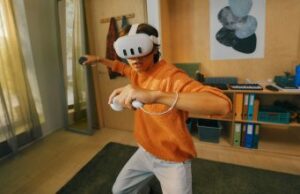Apple’s upcoming mixed reality headset has been the subject of many reports and rumors over the past few years—that’s just the nature of the Cupertino-based black box. Now a new report from the Financial Times alleges we may see the company’s first XR device unveiled this summer.
The headset, which is still unnamed, is allegedly nearing its big unveiling, which is said to take place in June 2023, or around when the company traditionally holds its Worldwide Developers Conference (WWDC).
The report maintains Apple CEO Tim Cook is the principal force pushing the device’s launch forward this year, which has apparently been a source of tension since as far back as early 2016.
The company’s operations team reportedly found itself at odds with the industrial design team, the former wanting to push out an early version of the headset while the latter hoped to delay in order to slim down the device.
Cook is ostensibly backing the operations team, as he allegedly hopes to push out the first version of the company’s XR headset, which is said to be targeting enthusiasts at an eye-watering $3,000 price point.
Citing sources familiar with Apple’s plans, the company is expected to only sell around one million units of the XR headset over the course of 12 months.
Relatively low sales targets notwithstanding—Apple sells 200 million iPhones per year—the company is expected to go in for a “marketing blitz” to attract prospective users.
According to a Bloomberg report earlier this year, Apple may be putting its plans to release a full AR headset on hold, as the company is allegedly planning what is described as a “lower-cost version” of its MR headset first. That cheaper version is said to target a 2024 or early 2025 launch window.
Note: This list of the headset’s prospective features and specs have been gathered from a few disparate reports. None of the below has been confirmed by Apple, so please take anything you read here with a large grain of salt:
Reported Apple MR Specs
- Resolution: Dual Micro OLED displays at 4K resolution (per eye)
- FOV: 120-degrees, similar to Valve Index
- Chipset: Two 5nm chips. Includes a main SoC (CPU, GPU, and memory) and a dedicated image signal processor (ISP). Chips communicate via a custom streaming codec to combat latency.
- Battery: Waist-mounted battery, connected via MagSafe-like power cable to the headset’s headband. Two-hour max battery life, although hotswappable for longer sessions.
- Passthrough: ISP chip contains custom high-bandwidth memory made by SK Hynix, providing low latency color passthrough
- Audio: H2 chip, providing ultra-low latency connection with the second-generation AirPods Pro and future AirPods models. No 3.5mm and possible no support for non-AirPod BT headphones.
- Controller: Apple is said to favor hand-tracking and voice recognition to control the headset, but it has tested a “wand” and a “finger thimble” as alternative control input methods.
- Prescription Lenses: Magnetically attachable custom prescription lenses for glasses-wearers.
- IPD Adjustment: Automatic, motorized adjustment to match the wearer’s interpupillary distance.
- Eye Tracking: At least one camera per-eye for things like avatar presence and foveated rendering
- Face & Body Tracking: More than a dozen cameras and sensors capture both facial expressions and body movements, including the user’s legs.
- Room Tracking: Both short- and long-range LiDAR scanners to map surfaces and distances in three dimensions.
- App Compatibility: Said to have the ability to run existing iOS apps in 2D.
Design Rumors
- Outer Shell: Aluminum, glass, and carbon fiber to reduce its size and weight. Cameras are largely concealed for aesthetic reasons.
- Presence Displays: Outward-facing display can show user’s facial expressions and also presumably eye movements. Said to be an always-on display similar in latency and power draw of Apple Watch or iPhone 14 Pro.
- Dedicated Passthrough Switch: Digital Crown-like dial on its right side to switch between VR and passthrough.
- Headstrap: Various available, including consumer-focused headstrap similar in material to Apple Watch sport bands with built-in speakers. Unspecified, but different headstrap targeted at developers.



